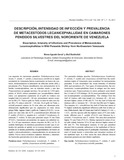Mostrar el registro sencillo del ítem
Descripción, intensidad de infección y prevalencia de Metacestodos Lecanicephallidae en camarones Peneidos silvestres del nororiente de Venezuela
| dc.rights.license | http://creativecommons.org/licenses/by-nc-sa/3.0/ve/ | |
| dc.contributor.author | Aguado García, Nieves | |
| dc.contributor.author | Bashirullah, Abul K. | |
| dc.date.accessioned | 2011-03-17T19:26:20Z | |
| dc.date.available | 2011-03-17T19:26:20Z | |
| dc.date.issued | 2011-02-28 | |
| dc.identifier.issn | 0798-2259 | |
| dc.identifier.uri | http://www.saber.ula.ve/handle/123456789/32682 | |
| dc.description.abstract | Las especies de camarones peneidos: Farfantepenaeus brasiliensis, F. notialis, F. subtilis y Litopenaeus schmitti de la región nororiental de Venezuela fueron examinados en busca de cestodos, determinándose la intensidad de infección media (IIM) y prevalencia (Pv). Fueron identificados dos metacestodos de la familia Lecanicephallidae, uno en intestino medio y otro tipo Polypocephalus en ganglio nervioso. De un total de 1.370 ejemplares, el 36,4% estuvo parasitado por Lecanicefálidos intestinales. Los ejemplares capturados en el golfo de Cariaco con longitud total (Lt) entre 60 – 89 mm, presentaron valores mayores de IIM y Pv. Para el golfo de Paria, la clase de talla con mayor IIM y Pv estuvo entre 90 – 120 mm. En el golfo de Paria, L. schmitti presentó valores de Pv más altos con diferencia estadísticamente significativa que los capturados en otras áreas (playa Píritu, laguna Unare y golfo de Cariaco) (P<0,01). La especie con valor más alto de Pv y estadísticamente diferente fue F. subtilis, (P<0,01) y, seguida de L. schmitti, F brasiliensis y finalmente F. notialis. El área que presentó mayor Pv fue Paria (P<0,01). Camarones provenientes de aguas con salinidad entre 10 a 25 ups mostraron valores mayores de IIM y de Pv. El análisis histológico de intestinos parasitados mostró que la adhesión del parásito al epitelio de la mucosa intestinal ocasiona pérdida de la lámina periotrófica, desprendimiento del borde de cepillo o microvellocidades y desprendimiento de secciones del epitelio. Pocos casos mostraron capilares dilatados y abundantes hemocitos granulocitos en el área afectada. | es_VE |
| dc.language.iso | es | es_VE |
| dc.publisher | SABER-ULA | es_VE |
| dc.rights | info:eu-repo/semantics/openAccess | |
| dc.subject | Farfantepenaeus brasiliensis | es_VE |
| dc.subject | F. notialis | es_VE |
| dc.subject | F. subtilis | es_VE |
| dc.subject | Litopenaeus schmitti | es_VE |
| dc.subject | Parásitos | es_VE |
| dc.title | Descripción, intensidad de infección y prevalencia de Metacestodos Lecanicephallidae en camarones Peneidos silvestres del nororiente de Venezuela | es_VE |
| dc.title.alternative | Description, intensity of infections and prevalence of Metacestodes Lecanicephallidea in wild Penaeids shrimp from northeastern Venezuela | es_VE |
| dc.type | info:eu-repo/semantics/article | |
| dc.description.abstract1 | The penaeids shrimps species: Farfantepenaues brasiliensis, F. notialis, F. subtilis and Litopenaeus schmitti from the northeastern region of Venezuela were examined for metacestodes parasites. It was determined the mean intensity of infection (IIM) and prevalence (P). Two types of metacestodes: the metacestodes Lecanicephallidae found in midgut and the metacestodes type Polypocephalus in nerve periopod were identified. A total of 1370 shrimps, 36.4% were parasitized by intestinal lecanicephalids Lecanicephallidae. The shrimps from the Gulf of Cariaco with total length (Lt). between 60 – 89 mm, showed higher values of IIM and Pv. For the Gulf of Paria the shrimps with Lt. between 90 – 120 mm had IIM and Pv higher. The samples of L. schmitti from the Gulf of Paria had values of Pv higher statistically significant difference with that of other areas (Piritu beach, lake of Unare and Gulf of Cariaco) Z = 4.6, = 0.01, and the species with the highest value of Pv and statistically different was F. subtilis (P<0.01) and followed by L. schmitti, F brasiliensis and F. notialis. The area that presented higher Pv was Paria (P<0.01). Shrimp captured in zones of water with salinity between 10 to 25 ups showed higher values of IIM and Pv. The histological analysis of mid gut parasited showed that to parasite adherence to the epithelium of the intestinal mucosa causing loss of peritrophic membrane, detachment of brush border o microvillus and detached sections of the epithelial layer. In a few cases the area affected showed abundant granulocyte and dilated capillaries. | es_VE |
| dc.description.colacion | 7-15 | es_VE |
| dc.description.email | nievesaguado@yahoo.com | es_VE |
| dc.description.frecuencia | Bimestral | |
| dc.identifier.depositolegal | 199102ZU46 | |
| dc.publisher.pais | Venezuela | es_VE |
| dc.subject.institucion | Universidad del Zulia (LUZ) | es_VE |
| dc.subject.institucion | Universidad de Los Andes (ULA) | es_VE |
| dc.subject.keywords | Farfantepenaeus brasiliensis | es_VE |
| dc.subject.keywords | F. notialis | es_VE |
| dc.subject.keywords | F. subtilis | es_VE |
| dc.subject.keywords | Litopenaeus schmitti | es_VE |
| dc.subject.keywords | Parasites | es_VE |
| dc.subject.seccion | Revista Científica: Fauna Silvestre | es_VE |
| dc.subject.thematiccategory | Medio Ambiente | es_VE |
| dc.subject.tipo | Revistas | es_VE |
| dc.type.media | Texto | es_VE |
Ficheros en el ítem
Este ítem aparece en la(s) siguiente(s) colección(ones)
-
Revista Científica - 2011- Vol. XXI - No. 001
Enero - Febrero 2011


